Giving Back: Udall Center Director Andrea Gerlak on Serving Her Community as a Water Policy Expert
In addition to her dual UArizona appointments as Director of the Udall Center and Professor in the School of Geography, Development and Environment, Andrea Gerlak also represents the university on two local volunteer water advisory boards.
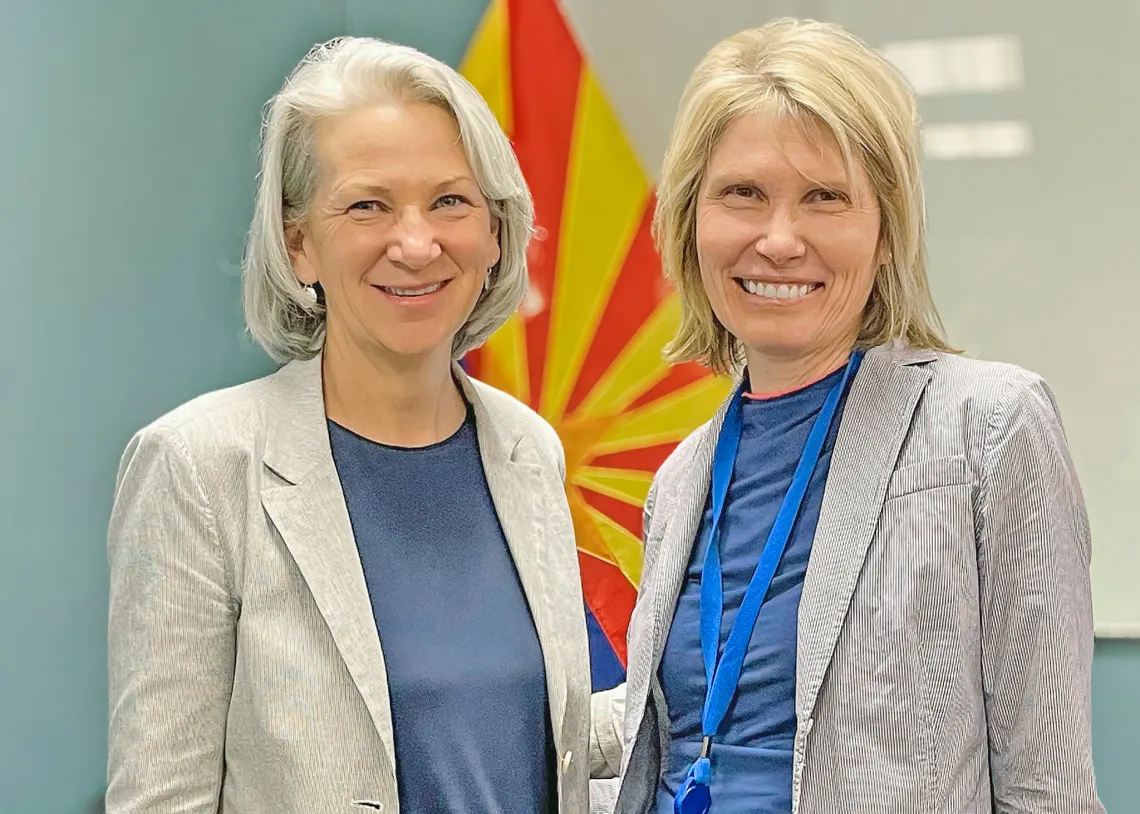
Andrea Gerlak (right) poses with fellow Tucson Water Citizen's Water Advisory Committee member Juliet McKenna during a meeting in the spring of 2024.
It was during a research-focused sabbatical in the spring of 2023, shortly after her appointment to her role as Director of the Udall Center for Studies in Public Policy, that Andrea Gerlak started thinking about how to apply her more-than two decades of water policy expertise in a way that would directly benefit her community.
Gerlak had been publishing peer-reviewed research on international policy, water governance and environmental justice in prominent journals since the late 1990s. But, as a career academic, she had started to think more critically about the role that scientific research played in policymaking.
With that in mind, Gerlak began looking for ways to play a more active role in the policy sphere in her community and it didn’t take her long to find an outlet.
This past year, Gerlak served on two public water advisory committees: the Citizens’ Water Advisory Committee for the City of Tucson and the Water Conservation Grant Committee for the Water Infrastructure Finance Authority of Arizona’s Water Conservation Grant Fund.
As a City Manager nominee for the City of Tucson’s Citizens’ Water Advisory Committee (CWAC), Gerlak serves alongside 14 other Tucsonans that include the Tucson Water Director, hydrologists, non-profit professionals, attorneys and professionals from the real estate and development industries.
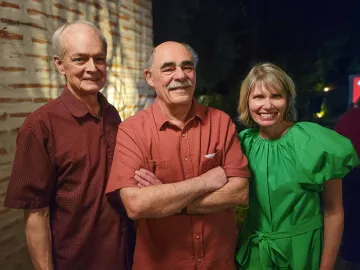
Former Udall Center directors Stephen Cornell and Robert Varady with current director Andrea Gerlak at Varady's retirement party in the summer of 2023.
Some members of the CWAC represent the Tucson Wards in which they live. Others are appointed by the City Manager. All CWAC nominees are approved by the Mayor and Council to serve an eight-year term during which they meet monthly to “Act as the official advisory body on Water Capital Improvement Program planning and rate structure formulation to City Government,” according to the City of Tucson’s information page on the subject.
Gerlak’s other volunteer appointment with the Water Conservation Grant Committee (WCGC) for the Water Infrastructure Finance Authority of Arizona’s Water Conservation Grant Fund involved reviewing large grant proposals submitted by water providers like municipalities, Tribal entities, and public and private water companies competing for access to a $200-million pool of funds set aside by the Arizona Legislature in 2022 to conserve Arizona’s water supply.
The final meeting of the WCGC took place on May 9, 2024. At that meeting, committee members reviewed the last 39 grant applications submitted to the Water Conservation Grant Fund in an effort to divvy out the last $35 million remaining in the program’s coffers.
We sat down with Gerlak to learn more about her volunteer service on these committees. Here’s what she had to say:
Q&A With Andrea Gerlak
How did you find yourself serving in these volunteer roles as a water policy expert?
GERLAK: In the recent past, UArizona has consistently had someone serving on the City of Tucson’s Citizen’s Water Advisory Committee (CWAC). It was my colleague (the late) Tom Meixner who served for a long time in this position.
I’ve dedicated my career to looking critically at water governance in an academic way. And, having recently been appointed as the director of the Udall Center, which is an applied center, I started thinking, How can I really bring what I've learned to bear and serve my community better? So, I offered my services to be on this advisory committee.
What does the Citizens’ Water Advisory Committee do?
GERLAK: The CWAC meets monthly and, really, what we do is we're trying to guide the City and Tucson Water on its water initiatives, its water activities and what it's doing for the community.
The meeting often starts with a City representative reporting on a particular topic like “What is the City
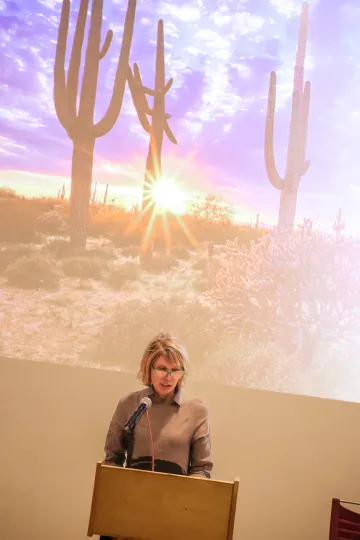
Andrea Gerlak presents at a Colorado River Governance Symposium in February 2024.
doing with drought planning?” or “How are we managing our Colorado River allocation?” Topics like that.
The Committee members then ask questions and offer insights to help flesh out programs, think of potential challenges and avert problems in the future. But there's also an element of offering novel information about what’s happening in the world of water and water policy, and sharing what we're learning with City officials.
Each CWAC member also serves on a subcommittee that provides more specific insights on a certain topic area. I'm on the Conservation and Education Subcommittee, for example, and we recently had a meeting in which (the Administrator of the Conservation & Stormwater Resources Division of Tucson Water) James MacAdam gave a presentation discussing a request from Tucson’s Mayor and Council to see what other cities are doing to reach net-zero water usage and determine what might be possible here.
Leading up to that meeting, Tucson Water got a consultant and they looked at all these cities in the Southwest that are doing something in an effort to reach net zero.
They identified commonalities in those efforts, and then (MacAdams) started to think about what we could do here. He then took all of that information back to the Mayor and Council to see if they wanted to do something like pass a new ordinance or fund a new program.
So, the City then shared their findings with my CWAC subcommittee to see what we might be able to contribute to those deliberations from our experience.
We pose questions and offer ideas that can help shape what Tucson Water does going forward. So, we're a little bit like an advisory group that is there to give feedback and, hopefully, avert potential challenges, come up with other ideas and look for potential partnerships.
I think of it as an accountability measure put in place by the water authority. We’re just citizens keeping an eye on things and offering some sort of expertise that could help improve how we manage water.
Is there any benefit to the university or to you directly associated with serving on this committee?
GERLAK: I think the university needs to be represented in these groups. We have a lot of expertise here.
I'm already seeing pilots for initiatives and efforts that (Tucson Water is) starting and I'm thinking, Who can I connect them with at the university for that so we can be engaged, so we can study it, so we can bring in students to get involved?
So, I see it as an opportunity to train our students – undergrads and grad students – and to better engage the university more broadly.
It's about creating opportunities for the university to share our expertise and other things that we might offer. So, I think it's a good thing to do for both the City and for the university.
What is it that you bring to the role that is unique to you?
GERLAK: I think it helps that I'm always thinking about equity and justice: Who's engaged and who benefits? Who are the winners and losers from what they're proposing?
I really like the idea of experimentation and piloting, but only if we're then studying it and learning and
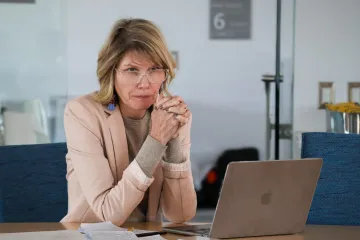
Andrea Gerlak listens as a colleague speaks during a grant writing workshop in Tucson in February 2024.
feeding what we learn back into the system.
So, I’m always asking those questions: How long are we going to pilot it? How are we going to get data? What kind of data do we want? How do we measure effectiveness?
I feel like I’m there to make sure we’re not just jumping in and doing a project blindly, but that we’re going about things really systematically and with reflection and learning so we know if we got the outputs we were trying for.
I think I also provide some level of policy and governance expertise. I think that what government does matters, and that government should be solving problems.
So, to me, this work should essentially be democracy in action and I want to make sure that it is. And I hope that I can.
What can you tell us about your role on the Water Conservation Grant Committee (WCGC)? How did you find yourself in that position?
GERLAK: The WCGC is a brand new committee. It was established in 2022, so I was actually invited to be an original member of that committee.
The position came out of Arizona State legislation from 2022 that provided $200 million in grant funds to help water providers across the state save water and improve the reliability of our water supply.
The program invites water providers in Arizona – and that can take a lot of forms, from private companies, to municipalities like the City of Tucson, to Tribal entities and other organizations working with water providers – it invites them to apply for grants between $250,000 and $3 million to do some sort of water conservation project in their service area.
The role of the WCGC is to essentially listen to those grant proposals and evaluate them for efficacy and priority in order to help determine which projects to fund.
The legislation is very specific about who has to serve on this committee. They have to have a representative of different entities including a big county, a small county, a rural area, a natural resource conservation district and one university in the state. I was selected as the university representative.
What is the goal of this program and what sort of projects are being funded?
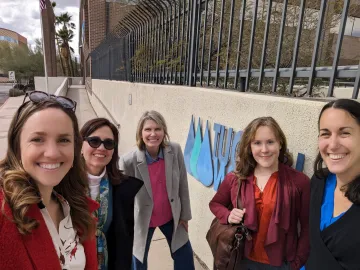
Andrea Gerlak (center) poses with Udall Center researchers (from left) Gina Gilson, Adriana Zuniga-Teran, Gemma Smith and Adrienne Brown outside the Tucson Water building in early 2024.
Gina Gilson
GERLAK: The goal of the Water Conservation Grant Fund is to conserve 5 million acre feet of water through the projects that receive state funding.
There is also a goal to implement at least one water conservation project in all 15 Arizona counties, so it’s really great to see a real diversity of areas and people that are benefiting from this program.
The types of proposals that we’re seeing fall into a few distinct categories. They include efforts to improve metering to make it easier to track water usage and identify leaks in systems more quickly; upgrading to more efficient hardware and infrastructure; removing turf; planting drought-tolerant vegetation; making improvements to agricultural systems; and improving efforts to reuse wastewater and recharge underground aquifers.
Applying organizations have to put up a 25 percent match, so it’s not like they are just getting free money to throw at any random project. They have to at least have some skin in the game to make sure there is a real commitment to ensuring their proposed projects have the best possible chance for success.
Are there plans to continue this conservation grant program once you’ve given out all of the money set aside for it?
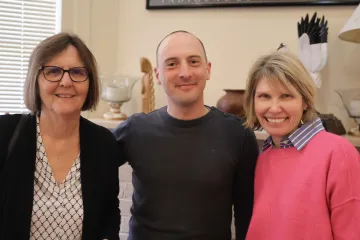
UArizona School of Government & Public Policy Director Edella Schlager, Assistant Professor at the Université catholique de Louvain, Belgium, Stéphane Moyson and Andrea Gerlak in the Udall Center lobby after Moyson's January 2024 talk on international collaborative governance.
GERLAK: As of right now, this is just a one-time thing.
If it does well and actually contributes to water savings and people like it, hopefully the Arizona legislature will see that it’s a worthwhile project and renew it later. But, as of this moment, it’s a flat $200 million that is available and we’ve been asked to give it all out relatively quickly.
One thing that I hope they will do is to establish an assessment plan to follow up after these projects
were put in place to see if they were effective and to determine if the overall grant program was able to meet its goals.
$200 million is a lot of money. The state government doesn't often allocate this much money for these types of large-scale conservation programs, and it could be tough to justify a similar expenditure in the future if we can’t prove that our efforts made a real impact.
Is there anything particularly interesting or exciting about the proposals you evaluated for this program?
GERLAK: It’s been great to see the variety of proposals coming through. And the vast majority of them are really well composed and thoughtful.
Some folks are really trying some new things that have never been done before, like switching to digital meters that automatically feed information back to the water providers rather than having to send someone down to actually physically read a meter themselves to determine someone’s water usage.
I’ve also been really excited about the partnerships we’re seeing.
If you look across a lot of the grants that have been awarded, it isn't just one city or county that is submitting these proposals. It’s the City of Phoenix in partnership with the Bonneville Environmental Foundation, or Pima County in partnership with Native Seeds/SEARCH and, in some cases, multiple municipalities or water districts are working together on the same proposal.
Those things are great to see because funding those types of partnerships will often lead to other partnerships and other projects. And that’s an important part of getting us to the other side of our current water shortage.
The state isn’t going to be able to solve this crisis alone. We need all the different private sector actors, schools, NGOs, cities, counties, agricultural producers – all the different entities to take part in these conservation efforts.
This program is bringing all that together, and that's kind of cool.

